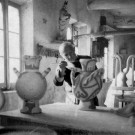Picasso Ceramics – Originals, Editions and Variants
The term “Picasso Ceramics” generally refers to the pitchers, plates, vases and plaques that were recreated by the artisans at the Madoura pottery in the South of France after ceramics personally decorated by Pablo Picasso. These “authentic replicas” and “original prints” were done in editions of from 25 to 500 and were sold inexpensively to tourists until Japanese demand in the 1980s caused a price explosion. For the past thirty years EDITION PICASSO CERAMICS that might originally have been purchased for under a hundred dollars have sold for tens of thousands.
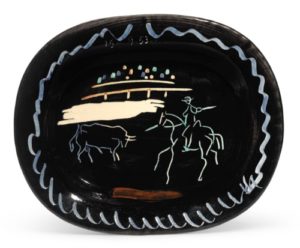
EDITION PICASSO CERAMIC AR 198 – one of 500 copies – sold at Sotheby’s London 4-10-2017 for $13,194
Because this is the age of “art as investment” people talk about the “Picasso ceramic market.” In order really to have a market for something you need a sufficient supply, a minimum trading volume and reliable information. The New York Stock Exchange for instance, requires member companies to fulfill various reporting requirements, have 1.1 million public shares outstanding and a monthly volume of 100,000. If you add up all the EDITION PICASSO CERAMICS (I once did), the total comes to almost 120,000 pieces. There’s a reliable catalogue raisonné and, while public sales of even the larger editions rarely exceed half a dozen per year, there are enough auction records over the past three decades to give the illusion of a market, albeit a thinly traded and highly inefficient one.
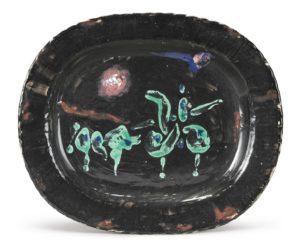
PICASSO CERAMIC ORIGINAL – personally decorated by Picasso sold at Sotheby’s in May 2017 for $32,500
But what about ceramics that Picasso personally painted? There were over 4,000 of these, including the prototypes after which the EDITION PICASSO CERAMICS were replicated. The vast majority of such PICASSO CERAMIC ORIGINALS were never offered for sale and are now in museums. Though dealers occasionally get hold of one and a few have made their way to auction, there have been years when it would have been difficult to find a ceramic hand-painted by Picasso for sale anywhere in the world. Nor is there anything approaching a definitive reference, though PICASSO CERAMIC ORIGINALS are discussed in a few books including the catalogue for the 1999 exhibition at the Met, “Picasso – Painter and Sculptor in Clay.” Dealers and auction houses like to call such ceramics “Unique,” perhaps not using the word “Original” so as not to draw attention to the fact that the EDITION PICASSO pieces are what some might call reproductions. However, the term “unique” can be misleading, as we shall shortly see.
In June 2015 Picasso’s granddaughter, Marina, put more than two hundred PICASSO CERAMIC ORIGINALS that she had inherited up for auction at Sotheby’s London. Coincidentally there was a sale of EDITION PICASSO CERAMICS the same day across town at Christies, giving a rare opportunity to compare prices of Picasso’s ORIGINALS versus EDITIONS. But adding a couple hundred of Marina’s ORIGINALS to the few already in circulation didn’t suddenly make this a reliable market. This can be seen from the spread between the sale prices and the estimates, which varied by tens of thousands of dollars. In an efficient market (like the NYSE) the difference between the bid and ask can be a penny.
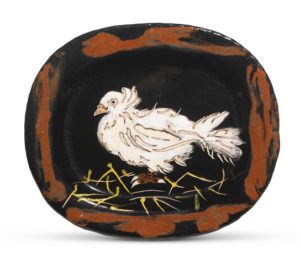
EDITION PICASSO AR 79, one of 300 copies. Between 2014 and 2017 there were more than a dozen sales of this ceramic between about $7,500 and $18,000.
In May 2017 Marina Picasso put more of her inherited pieces up for auction, this time at Sotheby’s in New York. Sotheby’s marketed this batch not as “Picasso ceramics,” but as “Works from the Collection of Marina Picasso.” In fact more than half the sale was comprised of drawings, which also made the three highest prices, but there were also PICASSO CERAMIC ORIGINALS, EDITION PICASSO CERAMICS, as well as another category that most collectors and many dealers are totally unaware of – EDITION PICASSO VARIANTS.
EDITION PICASSO VARIANTS are basically EDITION pieces apart from the official count that were for some reason decorated differently than the ceramics described in Alain Ramié’s definitive “Picasso – Catalogue of the Edited Ceramics.” There is virtually no information available about why such variations were created or how many exist.
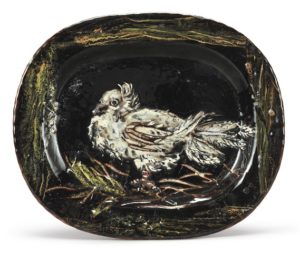
PICASSO CERAMIC VARIANT from Marina Picasso Collection brought $30,000 at Sotheby’s NY 18 May 2017
Picasso’s ideas evolved, and he often executed several slightly different versions of a ceramic. Perhaps the VARIANTS were tests, and ultimately a different version was selected for the EDITION PICASSO piece. Another possible explanation is that the artisans at the pottery were just fooling around. Madoura didn’t fire all the pieces of an EDITION at once. A small number were created at a time and another batch was fired only when the existing ones were sold. Maybe there was an extra blank, and someone couldn’t bear to just throw it away. Or maybe Picasso wanted to give a particular ceramic to a friend but the EDITION was closed out, so he just instructed Madoura to make a different, undocumented proof.
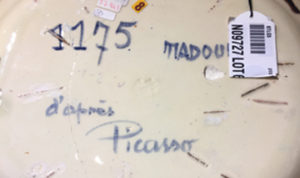
Picasso Dove Variant – reverse.
Whatever the reason for their existence, it’s generally been assumed that EDITION PICASSO VARIANTS were not created by Picasso personally. In the 1950s and 1960s EDITION PICASSO CERAMICS were inexpensive souvenirs; anything that Picasso personally decorated was in a different category entirely and scrupulously documented for the valuable object it was. Thus the VARIANTS that have made their way to auction have been considered mere curiosities and usually sell for prices comparable to the EDITION pieces.
The May 2017 sale of Marina Picasso’s odds and ends, however, has presented a new wrinkle in the status of EDITION PICASSO VARIANTS. The day I went to a viewing only junior people were available at Sotheby’s but I was told that every piece in the sale would come with a certificate from Claude Picasso saying that it was “unique.” Unique in the sense that it was painted personally by Picasso or unique in that it was an undocumented version of the EDITION PICASSO CERAMIC? The junior people weren’t clear, but what’s indisputable is that these ceramics had once belonged to Picasso and were part of the collection that Marina Picasso inherited from her grandfather.
Take a look at the EDITION PICASSO CERAMIC Dove above, AR 79, and the VARIANT from Marina Picasso’s collection. In the auction catalogue Marina Picasso’s Dove is one of the few ceramics in the sale not identified as unique, only as “Painted, glazed and incised ceramic.” It is marked on the reverse “d’apres Picasso” – “d’apres” means “after” in French. The logical conclusion is that it is not from Picasso’s hand; it is simply an EDITION PICASSO VARIANT.
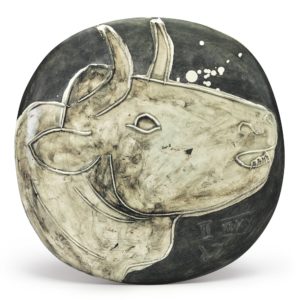
Marina Picasso’s EDITION PICASSO VARIANT Bull’s Profile sold for $62,500
It’s always a good idea to personally inspect an item you wish to buy at auction and to read carefully its catalogue description. Consider Marina Picasso’s Tête de Taureau for example. As with the Dove platter above, the catalogue entry for this Bull’s Profile plaque says nothing about its being unique, just that it’s in reverse in the EDITION piece.
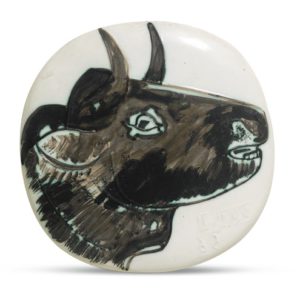
EDITION PICASSO Bull’s Profiles rarely sell for more than $6000.
Yet the ceramic brought $62,500 in the sale, which is curious because there are three different EDITION PICASSO versions of this same Bull’s Profile, adding up to a total of 1000 ceramics, and they generally bring under $6,000 at auction.
Are there other copies of this Bull’s Profile in reverse VARIANT? I have no idea, and as I said before, there is no way to find out. Certainly provenance can add value, but does the fact that Picasso had this VARIANT in his house (over the mantel? in the closet?) make it worth a 1000% premium? If so, why didn’t Marina Picasso’s Dove platter bring ten times the price for that EDITION piece?
Though no claim was made that Picasso personally decorated Marina Picasso’s Dove platter or her Bull’s Profile plaque, the Sotheby’s auction catalogue does give us some new information about VARIANTS, unequivocally stating: “Sometimes the decoration [of empreintes] would be replicated for the editions, but all the examples in the Marina Picasso collection were painted or otherwise decorated by the artist himself.”
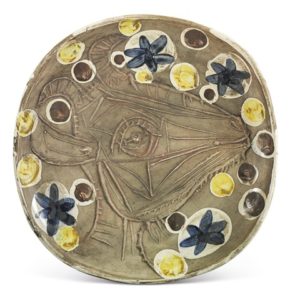
Marina Picasso’s Unique Version of an Empreinte Picasso brought $137,000.
“Empreinte originale” – also called “Original Print (or O.P.)”- was a technique whereby a mold reproduced Picasso’s raised structures in the wet clay. The catalogue description of each of such VARIANTS in the Marina Picasso collection calls it “a unique version of the empreinte.” So now we know that Picasso did personally create some VARIANTS, including a “unique version of the empreinte” Tête de Chevre (Goat’s Head), which sold for $137,000. (There are five different EDITION PICASSO versions of similar Goat’s Head empreintes in the catalogue raisonne (Ramié 151 – 155). Marina Picasso’s piece is a VARIANT of AR 154, the only EDITION Goat’s Head that has four Xs.)
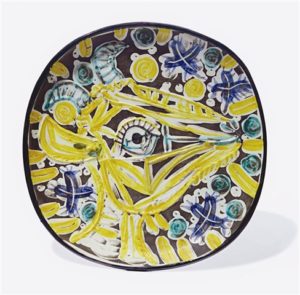
EDITION PICASSO CERAMIC AR 154. Goats Heads of the five different types generally bring between about $10,000 and $30,000 at auction
So are there any other “unique” copies of this same Goat’s Head VARIANT? The answer is yes – sort of. Another ceramic much like the one illustrated above came to auction on April 25, 2012, at Phillips de Pury & Co. in New York, where it was even described in the auction catalogue as “a unique variant” and sold for $21,250. The Phillips catalogue reported “There is an extremely similar image of a unique piece in the Marina Picasso Collection (Picasso Keramiek 1985 Museum Het Hruithuis).” Why was the Phillips “unique variant” created? Who decorated it and had the audacity to include nine yellow balls instead of the ten Picasso used in Marina’s ceramic?
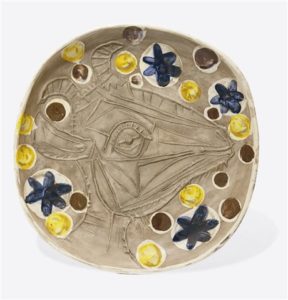
EDITION PICASSO VARIANT Goat’s Head brought just $21,250 in a 2012 auction at Phillips
Because different artisans replicated the EDITION PICASSO CERAMICS by hand after Picasso’s ORIGINALS, every EDITION piece is “unique” in that sense. Of necessity all VARIANTS were individually painted, too, and subtle differences in shapes and lines can always be found between two hand-painted recreations. You can see these for yourself if you examine this third VARIANT Goat’s Head that I found advertised on a dealer’s website as a “unique color variant.”
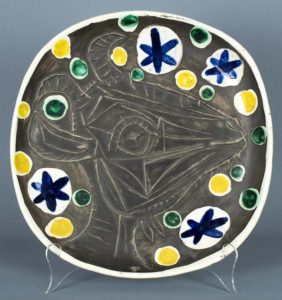
Another Picasso Goat’s Head “unique” variant
If “unique” VARIANTS aren’t enough to drive you crazy, there was actually a fourth category of Picasso Ceramics that were included in the Marina Picasso Sotheby’s May 2017 sale: damaged pieces. Remember that “d’apres Picasso” Dove platter EDITION PICASSO VARIANT? It had a great big crack right down the middle. Was this reason why it didn’t fetch more than about twice the price of the EDITION piece?
Picasso didn’t consider any ceramic a mistake that should be discarded; he believed something could be always be learned and even designated one of the Madoura artisans as his “mechanic” who would repair pieces that had been damaged in the firing. Several PICASSO CERAMIC ORIGINALS in this sale in fact had staples visible on the back to hold cracked pieces together.
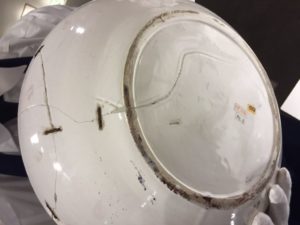
A cracked Picasso ceramic showing staples holding it together
Perhaps the VARIANT Dove became part of the Marina Picasso Collection because, no matter who had painted it, Picasso liked it despite the damage and took it home. After all, Picasso was the man who took a little owl with an injured claw home to live with him and Francois Gilot when he first came to Antibes in 1946. It was this owl that in fact inspired a number of his ceramics.
Marina Picasso’s unique Goat’s Head empreinte (it might be clearer to call it a PICASSO CERAMIC ORIGINAL – EDITION VARIANT) also had damage clearly visible on the reverse.
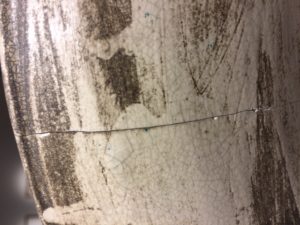
Marina Picasso Goat Head damage
So if Picasso didn’t care about damage, should potential buyers? Apparently the buyer of Ms. Picasso’s Goat’s Head VARIANT didn’t, if he or she was even aware that the plate had a crack. These days a lot of auction buyers don’t attend previews or even ask for condition reports, they just look at on-line pictures which rarely focus on a lot’s flaws. Certainly if there are three hundred copies of an EDITION PICASSO CERAMIC and one comes up for sale with a big chunk missing from the rim, people will likely want to wait for a better copy to their collection. However, earthenware ceramics can restored so expertly that even experienced dealers can’t detect any trace of damage by eye, and how many people really demand condition reports on pieces that look perfect? (For a discussion of how restoration can affect value of EDITION pieces, click here.)
With Picasso ORIGINALS, damage may not affect value at all. When casino magnate Steve Wynn put his elbow through Picasso’s painting La Rêve, which hedge fund honcho Steve Cohen had agreed to purchase for $139 million, Wynn sued his insurance company for $54 million in lost value. The suit was settled for an undisclosed amount, but a few years later Cohen turned around and bought the restored La Rêve anyway for $155 million, $16 million more than he was going to pay originally. After all, La Rêve was still a great Picasso, and it wasn’t like Cohen could go out an buy an undamaged version.
Because of paucity of supply and lack of information, the market for PICASSO CERAMIC ORIGINALS is so thin as to be practically non-existent. Consequently damage to such items may in fact present unique opportunities. Consider the top ceramic lot in Sotheby’s May 2017 sale of works from the Collection of Marina Picasso, Vase-femme Avec Bras-Anse, (Woman Vase with Arm Handle)” which brought $250,000.
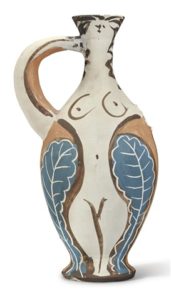
The catalogue visual of PICASSO CERAMIC ORIGINAL, Vase-femme avec un bras-anse
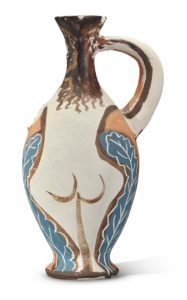
The vase’s rear end
Picasso’s son, Claude, in an essay in “Picasso, Painter and Sculptor in Clay” described how much of a challenge it was for his father to decorate a three dimensional object and how Picasso utilized the forms themselves in creative and whimsical ways – painting the picture of a vase on a vase, turning a handle into a flower, etc. Vase-femme Avec Bras-Anse is a perfect demonstration of how Picasso didn’t merely accept the limitations of shapes but used them to create something even better. However, many potential bidders may have seen only damage if they attended the preview. In the sale room it was evident that the “Arm Handle” had been restored and there had originally been another matching arm on the other side that was now missing entirely!
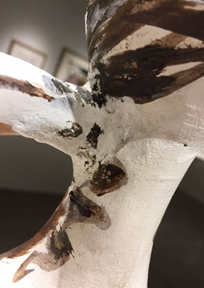
Picasso Original Repaired Arm
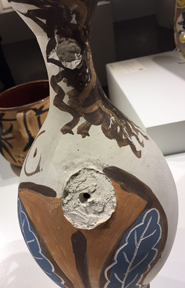
Picasso Original Missing Arm
Despite the damage the ceramic still soared above its $40,000 – $60,000 estimate. I think whoever snapped up this piece still got a tremendous bargain, even if he or she were one of those on-line buyers who had looked only at the pretty pictures in the auction catalogue and fainted when they opened the box. After all, $250,000 is a small price to pay for what is arguably a great PICASSO CERAMIC ORIGINAL. I mean we’re talking about just 1/1000th (all right, 0.00161290322%) of the $155,000,000 that Steve Cohen wound up paying for La Rêve! Who do you think got the better deal?
I think it’s extremely likely that the next time Vase-femme Avec Bras-Anse surfaces it will have both arms intact and no evidence that either of them had ever been anything other than perfect. Even if the new owner is a dealer who wants to make a big profit on the piece there would be no reason to conceal that it had been skillfully restored – a potential buyer will be hard-pressed to find a similar ceramic at any price.


